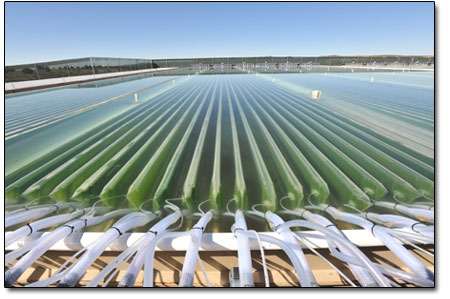|
| ||
| Green fuel SideStory: Growing green
by Will Sands
Solix is a firm based in Fort Collins that is devoted to algae-based biofuel. A Colorado State University spin-off, Solix started by identifying algae species that produce high fuel yields. Solix then brought those species to Southwest Colorado where they are currently yielding more than five times the amount of fuel per acre than other agriculture-based biofuels. The company selected La Plata County in part because of its moderate climate and abundant sunshine, which are optimal for algae production. The company also came to Southwest Colorado thanks to a partnership with the Southern Ute Tribe and located on a 10-acre site on tribal property. The Coyote Gulch facility is also unique in another way. “Coyote Gulch is special because it’s one of the largest production facilities in the U.S. where the algae feeds on carbon dioxide and waste water that are byproducts of oil and gas production,” explained Joanna K. Money, Solix’s vice-president of business development. Green diesel is chemically identical to traditional diesel fuel. Though the fuel can be produced from a variety of4 feedstocks, including both animal and vegetable sources, Solix believes that algae-based fuel offers the highest hope, and Solix has seen marked success at Coyote Gulch. However, don’t expect to see the algae-based biodiesel at the pump in the near future. Commercial viability hinges on several factors. “In recent years, there has been a realization that algae is a viable source for biofuel,” Money said. “However, the key issue is that the cost must come down, and that will happen when the fuel yields go up and the price of the technology drops. Right now, Solix is making strides on both of those fronts.” In the meantime, Solix will focus on commercializing, marketing and selling its algae growth system. To this end, the company secured in excess of $16 million in financing from its investors – The Southern Ute Alternative Energy Fund, Bohemian Ventures and I2BF Global Ventures – last week. It also changed its name from Solix Biofuels to Solix BioSystems to better reflect the company’s role as provider of systems rather than fuels. “This new round of financing from current investors demonstrates their continued excitement and support for our progress,” said Joel Butler, Solix’s chief executive officer. Solix is also excited about the company’s new offering and expects the market to respond. The system is geared toward growing algae in outdoor environments and offers a unique solution for customers seeking production outside the laboratory. Butler noted that Solix has been growing algae continuously for three years in Fort Collins; has experienced no production failures; and witnessed peak growth rates of more than 3,000 gallons of product per acre per year. Money added that algae oil is a wonder product and can be used to create food, bio-derived chemicals, surfactants, proteins, pigments and antioxidants among other things. “The viability of biofuel is still several years away,” Money said. “But the technology goes beyond targeting fuels. We think that in the near term, our customers will be using the process to create many other products.”
|



 The fuel of the future is quietly growing not far from Durango. Solix BioSystems has been successfully growing algae-based biofuel for the past two years at its Coyote Gulch Demonstration Facility, located nearby on Southern Ute Indian Reservation lands. The company now hopes to capitalize on that success and sell its proprietary photo-bioreactors all over the globe.
The fuel of the future is quietly growing not far from Durango. Solix BioSystems has been successfully growing algae-based biofuel for the past two years at its Coyote Gulch Demonstration Facility, located nearby on Southern Ute Indian Reservation lands. The company now hopes to capitalize on that success and sell its proprietary photo-bioreactors all over the globe.